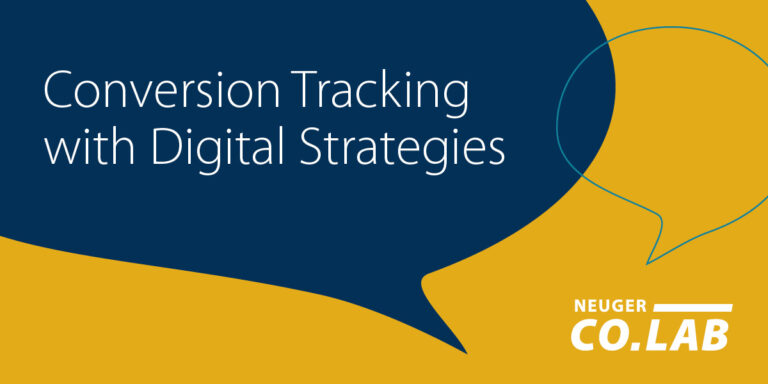
On August 26, 2020, we hosted our eleventh Neuger CO.LAB session, discussing the importance of digital conversion tracking and the tools that help organize your data. We were pleased to host about 20 participants who offered detailed discussion questions and insights of their own on how to implement tracking strategies to achieve outreach and business goals.
Session 11 Hosts
- Daniel Edwins, VP & Digital Team Lead
- Steven Wett, Senior Web Developer
Key Discussion Points
- The ultimate purpose of conversion tracking is to accomplish business goals. It allows you to compare various digital efforts and choose the best way to achieve your stated business goals (event promotion, lead generation, customer response to new products, etc.).
- Once you analyze your information acquired through tracking, you can tweak your business strategies and budget accordingly to maximize your outreach.
- Digital campaigns are usually paired with conversion tracking. It is necessary to research current consumer behaviors and trends when launching a campaign.
- To receive the conversion rates you want, design a compelling landing page on your website that targets your desired audience’s specific interests.
- Spoke and Hub model: your website is your hub, and the various social media channels and digital campaigns are your spokes – they all work together.
- Examples of conversions on a website are form completions, downloads, external link clicks, or product requests – any feature that has the consumer interacting with the landing pages you intended to draw them to.
- The basic steps to conversion tracking are: funnel modeling, impression determination, conversion goal setting, and audience research and segmentation.
- Google Analytics can measure website performance and track events and goals.
- Google Tag Manager can add tracking tags (Google Analytics, Facebook pixel, etc.) and trigger events to be tracked.
- Google Data Studio can easily create dynamic reports and dashboards.
- Google Optimize can be used for A/B testing landing pages.
- Google Search Console can monitor search performance and issues.
- Facebook Ads Manager can make, edit and analyze paid promotional Facebook and Instagram campaigns.
MOZ and SEMRush can monitor and optimize Search Engine performance. - Crazy Egg offers landing page heat maps to show where users are clicking.
Key Discussion Questions
Q: What are the roles of Google Analytics vs. CRMs? Do you have to have both?
There are several conversion tracking approaches, and you can certainly get by with only one. You can also use other analytical tools besides Google Analytics (see list in the discussion points section). The methodology of tracking is really tailored to the preexisting tools used by a company. Different tools are going to be used for different needs. If you want to transfer campaign information into CRMs, you can set up forms on landing pages that will be linked to your CRM database so it can transfer the form data efficiently and automatically.
Q: How do you make a decision on gated vs. non-gated content and avoid deterring consumers by asking them to give personal information?
It’s usually more effective to have an open user experience that requires little intercommunication from the consumer. If you plan on having a data collection campaign, ensure that the content and the information you are collecting are relevant to whomever you are targeting. Oftentimes when data collection campaigns are conducted, it is mediocre or irrelevant content, resulting in a low collection rate. Before sending it out, always preview your content and minimize the information fields you ask to have filled out; only ask for what you’re planning on using. Be explicit about privacy policies.
Q: Should you use UTM tracking codes?
If you’re going from a Google product to another Google product, you want to use the Google Click ID, which automatically transfers more data than if you were to use UTM tracking codes. Otherwise, UTM codes are generally beneficial because you can specify campaign names at the end of URLs. You can also measure the effectiveness of non-digital products using UTM tracking codes. UTM codes are especially useful in emails because you can track exactly what content the users are clicking on within the email.
Discussion Links
- Customer Journey Information
- Google Ad Benchmarks for YOUR Industry
- UTM Tracking Code URL Builder
- Ads ROI Information Sheet
- Google Ads Keyword Planner
In Summary
When developing a conversion tracking plan, it is crucial to do your homework before launching your campaign. You will not have successful conversion rates if you do not tailor your landing pages to your desired audience’s behavioral trends. When executed correctly, conversion tracking can drastically increase your outreach and customer retention. Thank you all for joining us this week, and we look forward to seeing you again for our future sessions.